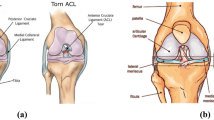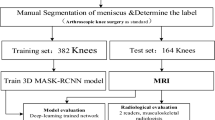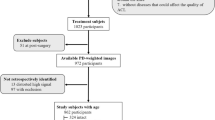Abstract
Purpose
To construct and validate a nomogram model that integrated deep learning radiomic features based on multiparametric MRI and clinical features for risk stratification of meniscus injury.
Methods
A total of 167 knee MR images were collected from two institutions. All patients were classified into two groups based on the MR diagnostic criteria proposed by Stoller et al. The automatic meniscus segmentation model was constructed through V-net. LASSO regression was performed to extract the optimal features correlated to risk stratification. A nomogram model was constructed by combining the Radscore and clinical features. The performance of the models was evaluated by ROC analysis and calibration curve. Subsequently, the model was simulated by junior doctors in order to test its practical application effect.
Results
The Dice similarity coefficients of automatic meniscus segmentation models were all over 0.8. Eight optimal features, identified by LASSO regression, were employed to calculate the Radscore. The combined model showed a better performance in both the training cohort (AUC = 0.90, 95%CI: 0.84–0.95) and the validation cohort (AUC = 0.84, 95%CI: 0.72–0.93). The calibration curve indicated a better accuracy of the combined model than either the Radscore or clinical model alone. The simulation results showed that the diagnostic accuracy of junior doctors increased from 74.9 to 86.2% after using the model.
Conclusion
Deep learning V-net demonstrated great performance in automatic meniscus segmentation of the knee joint. It was reliable for stratifying the risk of meniscus injury of the knee by nomogram which integrated the Radscores and clinical features.





Similar content being viewed by others
Data availability
The datasets generated and/or analyzed during the current study are available from the corresponding author on reasonable request.
Code availability
Not applicable.
References
Saygili A, Albayrak S (2020) Knee meniscus segmentation and tear detection from MRI: a review. Curr Med Imaging Rev 16(1):2–15. https://doi.org/10.2174/1573405614666181017122109
Fox AJ, Wanivenhaus F, Burge AJ, Warren RF, Rodeo SA (2015) The human meniscus: a review of anatomy, function, injury, and advances in treatment. Clin Anat 28(2):269–287. https://doi.org/10.1002/ca.22456
Kawahara T, Sasho T, Katsuragi J, Ohnishi T, Haneishi H (2017) Relationship between knee osteoarthritis and meniscal shape in observation of Japanese patients by using magnetic resonance imaging. J Orthop Surg Res 12(1):97. https://doi.org/10.1186/s13018-017-0595-y
Malanga GA, Chirichella PS, Hogaboom NS, Capella T (2021) Clinical evaluation of micro-fragmented adipose tissue as a treatment option for patients with meniscus tears with osteoarthritis: a prospective pilot study. Int Orthop 45(2):473–480. https://doi.org/10.1007/s00264-020-04835-z
Bien N, Rajpurkar P, Ball RL, Irvin J, Park A, Jones E, Bereket M, Patel BN, Yeom KW, Shpanskaya K, Halabi S, Zucker E, Fanton G, Amanatullah DF, Beaulieu CF, Riley GM, Stewart RJ, Blankenberg FG, Larson DB et al (2018) Deep-learning-assisted diagnosis for knee magnetic resonance imaging: development and retrospective validation of MRNet. Plos Med 15(11):e1002699. https://doi.org/10.1371/journal.pmed.1002699
von Schacky CE, Sohn JH, Liu F, Ozhinsky E, Jungmann PM, Nardo L, Posadzy M, Foreman SC, Nevitt MC, Link TM, Pedoia V (2020) Development and validation of a multitask deep learning model for severity grading of hip osteoarthritis features on radiographs. Radiology 295(1):136–145. https://doi.org/10.1148/radiol.2020190925
Subhas N, Li H, Yang M, Winalski CS, Polster J, Obuchowski N, Mamoto K, Liu R, Zhang C, Huang P, Gaire SK, Liang D, Shen B, Li X, Ying L (2020) Diagnostic interchangeability of deep convolutional neural networks reconstructed knee MR images: preliminary experience. Quant Imag Med Surg 10(9):1748–1762. https://doi.org/10.21037/qims-20-664
Garwood ER, Tai R, Joshi G, Watts VGJ (2020) The use of artificial intelligence in the evaluation of knee pathology. Semin Musculoskel R 24(01):21–29. https://doi.org/10.1055/s-0039-3400264
Balakrishnan R, Valdés HM, Farrall AJ (2021) Automatic segmentation of white matter hyperintensities from brain magnetic resonance images in the era of deep learning and big data - a systematic review. Comput Med Imaging Graph 88:101867. https://doi.org/10.1016/j.compmedimag.2021.101867
Barra D, Nicoletti G, Defeudis A, Mazzetti S, Panic J, Gatti M, Faletti R, Russo F, Regge D, Giannini V (2021) Deep learning model for automatic prostate segmentation on bicentric T2w images with and without endorectal coil. Annu Int Conf IEEE Eng Med Biol Soc 2021:3370–3373. https://doi.org/10.1109/EMBC46164.2021.9630792
Zhu J, Bolsterlee B, Chow B, Cai C, Herbert RD, Song Y, Meijering E (2021) Deep learning methods for automatic segmentation of lower leg muscles and bones from MRI scans of children with and without cerebral palsy. Nmr Biomed 34(12):e4609. https://doi.org/10.1002/nbm.4609
Grøvik E, Yi D, Iv M, Tong E, Rubin D, Zaharchuk G (2020) Deep learning enables automatic detection and segmentation of brain metastases on multisequence MRI. J Magn Reson Imaging 51(1):175–182. https://doi.org/10.1002/jmri.26766
Zhou J, Zhang Y, Chang KT, Lee KE, Wang O, Li J, Lin Y, Pan Z, Chang P, Chow D, Wang M, Su MY (2020) Diagnosis of benign and malignant breast lesions on DCE-MRI by using radiomics and deep learning with consideration of peritumor tissue. J Magn Reson Imaging 51(3):798–809. https://doi.org/10.1002/jmri.26981
Kavur AE, Gezer NS, Barış M, Şahin Y, Özkan S, Baydar B, Yüksel U, Kılıkçıer Ç, Olut Ş, Bozdağı AG, Ünal G, Dicle O, Selver MA (2020) Comparison of semi-automatic and deep learning-based automatic methods for liver segmentation in living liver transplant donors. Diagn Interv Radiol 26(1):11–21. https://doi.org/10.5152/dir.2019.19025
Kong Z, Li T, Luo J, Xu S (2019) Automatic tissue image segmentation based on image processing and deep learning. J Healthc Eng 2019:2912458. https://doi.org/10.1155/2019/2912458
Kim SH, Lee H, Jang Y, Chun K, Park Y (2021) Diagnostic accuracy of magnetic resonance imaging in the detection of type and location of meniscus tears: comparison with arthroscopic findings. J Clin Med 10(4):606. https://doi.org/10.3390/jcm10040606
Gillies RJ, Kinahan PE, Hricak H (2016) Radiomics: images are more than pictures, they are data. Radiology 278(2):563–577. https://doi.org/10.1148/radiol.2015151169
Milletari F, Navab N, Ahmadi S (2016) V-net: fully convolutional neural networks for volumetric medical image segmentation. In: 2016 fourth international conference on 3D vision (3DV). IEEE, pp 565–571
Stoller DW, Martin C, Crues JR, Kaplan L, Mink JH (1987) Meniscal tears: pathologic correlation with MR imaging. Radiology 163(3):731–735. https://doi.org/10.1148/radiology.163.3.3575724
Roblot V, Giret Y, Bou Antoun M, Morillot C, Chassin X, Cotten A, Zerbib J, Fournier L (2019) Artificial intelligence to diagnose meniscus tears on MRI. Diagn Interv Imag 100(4):243–249. https://doi.org/10.1016/j.diii.2019.02.007
Ma J, Deng Y, Ma Z, Mao K, Chen Y (2021) A liver segmentation method based on the fusion of VNet and WGAN. Comput Math Method M 2021:1–12. https://doi.org/10.1155/2021/5536903
Kuiper RJA, Sakkers RJB, Stralen M, Arbabi V, Viergever MA, Weinans H, Seevinck PR (2022) Efficient cascaded V-net optimization for lower extremity CT segmentation validated using bone morphology assessment. J Orthop Res 40(12):2894–2907. https://doi.org/10.1002/jor.25314
Kanakatte A, Bhatia D, Ghose A (2021) Heart region segmentation using dense VNet from multimodality images. In: Annual International Conference of the IEEE Engineering in Medicine and Biology Society. IEEE Engineering in Medicine and Biology Society. Annual International Conference 2021. IEEE, pp 3255–3258. https://doi.org/10.1109/EMBC46164.2021.9630303
Hua R, Huo Q, Gao Y, Sui H, Zhang B, Sun Y, Mo Z, Shi F (2020) Segmenting brain tumor using cascaded V-nets in multimodal MR images. Front Comput Neurosci 14:9. https://doi.org/10.3389/fncom.2020.00009
Balachandran VP, Gonen M, Smith JJ, DeMatteo RP (2015) Nomograms in oncology: more than meets the eye. Lancet Oncol 16(4):e173–e180. https://doi.org/10.1016/S1470-2045(14)71116-7
Nguyen JC, De Smet AA, Graf BK, Rosas HG (2014) MR imaging-based diagnosis and classification of meniscal tears. Radiographics 34(4):981–999. https://doi.org/10.1148/rg.344125202
Funding
This study has received funding by the Medical Health Science and Technology Commission of Zhejiang Province, China (No. 2021KY240, 2023KY162, 2023KY953), the Traditional Chinese Medicine Science and Technology Commission of Zhejiang Province, China (No. 2023ZL571), and the Hangzhou Biological Medicine and Health Industry Development Support Science and Technology Project (No. 2021WJCY028).
Author information
Authors and Affiliations
Contributions
All authors contributed to either the conception, design, data collection, or analysis. Material preparation and data collection were performed by Tao Zhen, Jing Fang, Mei Ruan, and Dacheng Hu. The first draft of the manuscript was written by Tao Zhen, and all authors commented on the previous versions of the manuscript. Tao Zhen and Luoyu Wang contributed to data analysis. Qijun Shen contributed to the final manuscript and supervised all the data. All authors read and approved the final manuscript.
Corresponding author
Ethics declarations
Ethics approval
This study was approved by the local institutional review board of the Hangzhou First People’s Hospital, Sichuan, China.
Consent to participate
Written informed consent was waived by the Institutional Review Board.
Consent for publication
We confirm that the manuscript has been read and approved by all named authors and that there are no other persons who satisfied the criteria for authorship but are not listed.
Conflict of interest
The authors declare no competing interests.
Additional information
Publisher’s note
Springer Nature remains neutral with regard to jurisdictional claims in published maps and institutional affiliations.
Supplementary information
ESM 1
(DOCX 248 kb)
Rights and permissions
Springer Nature or its licensor (e.g. a society or other partner) holds exclusive rights to this article under a publishing agreement with the author(s) or other rightsholder(s); author self-archiving of the accepted manuscript version of this article is solely governed by the terms of such publishing agreement and applicable law.
About this article
Cite this article
Zhen, T., Fang, J., Hu, D. et al. Risk stratification by nomogram of deep learning radiomics based on multiparametric magnetic resonance imaging in knee meniscus injury. International Orthopaedics (SICOT) 47, 2497–2505 (2023). https://doi.org/10.1007/s00264-023-05875-x
Received:
Accepted:
Published:
Issue Date:
DOI: https://doi.org/10.1007/s00264-023-05875-x




